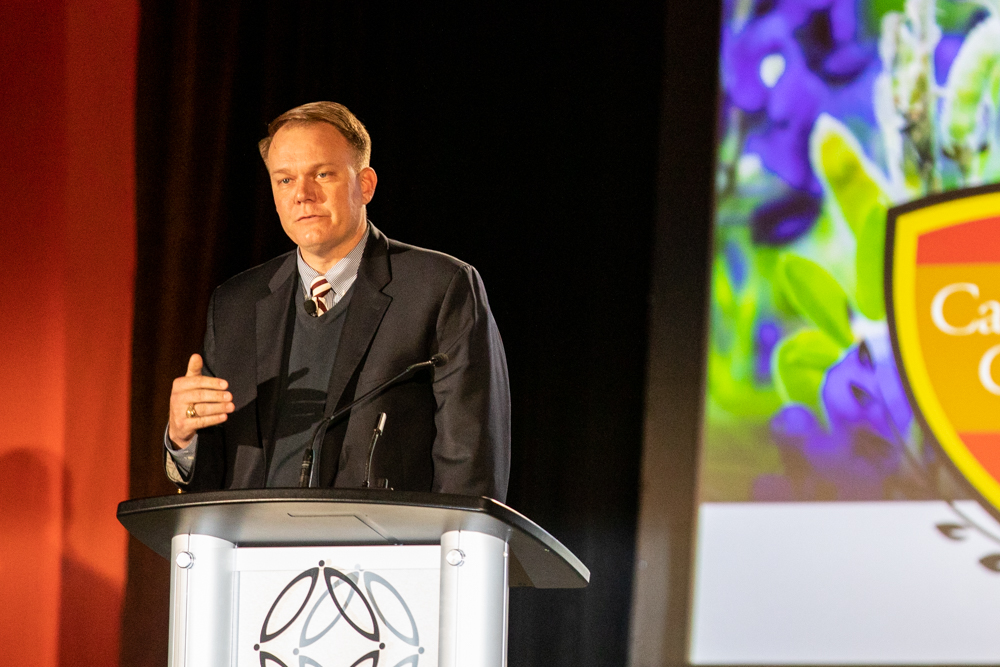
Don’t wince
Scientific evidence, economic incentive for sustainability
by Abbie Burnett
April 15, 2020
William Shakespeare wrote about every plot line ever told—betrayal, love, mystery, drama, tragedy, comedy—but he didn’t invent them.
Humanity has been telling the same stories for ages. But as each new generation walks the earth, they find new twists on the same basic tales. And we don’t grow tired of them.
Sustainability is an old story to cattle producers all over the world, but they’re finding new ways to talk about it.
Protein upcycling is a recent term that adds science to the narrative.
“The vast majority of what we do is take a resource that is largely un-utilizable by humans and turn it into something that humans can utilize,” Tryon Wickersham, Texas A&M University ruminant nutritionist, said at the 2020 Cattle Industry Convention in San Antonio.
“Everybody in the room knows that,” he said, “but the majority of people outside of this room don’t know it—so we need to speak to that.”
Humans need essential amino acids, and a shortage can stunt physical or mental development.
Corn, wheat and soybeans contain amino acids and human edible proteins (HEP), but meat provides more per calorie, Wickersham said.
Protein sources’ capacity to meet nutritional needs are ranked by digestible indispensable amino acid scores (DIASS). Animal proteins tally more than 100 DIASS versus corn at 36.8, so you need much less from animal sources to meet requirements, he said.
But at what cost? Are the resources consumed worth what those animals deliver?
No question, really. Wickersham calculated that a 1,000-head cow herd is fed just 24 pounds (lb.) of HEP during an entire year while producing more than 62,000 lb. of HEP.

“For every pound of HEP we put into the system, we get 2,600 lb. out,” he said. Taking that times beef’s protein quality ratio gets to a net protein contribution of 8,000. “Anything greater than 1 means the industry is not competing with humans for human edible protein.”
While it may take 770 lb. of corn to finish a steer, he put that in perspective.
“If I took that corn and I fed it to children, how many children could I feed?” he asked the audience.
Three. That would meet the toddlers’ amino acid requirement, but it would be difficult to consume that many calories from the grain and would lead to obesity.
Through protein upcycling—feeding that HEP to livestock—beef cattle feed 17 children with much fewer calories.
“We’re contributing to society by converting these low-quality sources of protein that humans can’t utilize into something that tastes amazing and does a great job of meeting their nutritional requirements,” he said.
But there are other measures and “sustainability is a balancing act,” Wickersham said. So his team tracks methane production per unit of HEP, too, demonstrating higher quality diets in feedyards help reduce greenhouse gas emissions.
“Anything we do from a production efficiency standpoint generally improves net protein contribution and the ability of cattle to feed people,” he said.
The underlying themes are timeless, but evolving technology and discoveries mean it’s time to share the story again.
Not only are consumers devouring it, but stakeholders are pressing for it, according to Wayne Morgan, Golden State Foods executive and president of the company’s protein products and sustainability branch.

As a $5 billion supplier to more than 125,000 restaurant chains and retail stores on five continents, Morgan feels the pressure sustainability questions are putting on companies like his and those it serves.
“Consumers say a lot of things and they don’t always respond with their wallets the same way they answer questions, but still, we can’t deny they’re an important part of this beef industry. We need to listen to what they’re saying,” Morgan said.
Investors, on the other hand, are responding with their wallets.
One of the biggest investor groups is BlackRock, controlling $7 trillion of the $80 trillion on earth.
“So when they announced they’re going to avoid investments in companies that present high sustainability-related risks, well, that ought to get your attention,” he said. “Anytime a major player in any business makes a shift, everybody else comes along.”
Morgan gets regular calls on Golden State Foods’ sustainability initiatives.
“How are we going to do better? How are we going to make improvements on greenhouse gas emissions? Save water? Reduce packaging?”
The Golden State Foods plan includes logistics, environmental scorecards, third-party audits, pilot projects and new data tracking technologies through IBM Blockchain.
How does he want the cattle community to answer those questions?
For starters, “don’t wince” every time you hear the word sustainability, Morgan advised.
Shakespeare wasn’t the first storyteller and neither are producers.
“We want you to embrace it,” he said, challenging the audience to change the sustainability narrative and make it their own.
You may also like
CAB Sets Sales Records, Sees Historically High Brand Acceptance Rates
In an otherwise tough time in the beef business, sales and supply records have been a bright spot. The positive numbers mean that quality beef production has not let up, and beef demand is holding. Consumers have proven the value proposition: the good stuff is worth a little more money, for a better eating experience.
Feeding Quality Forum Dates Set Earlier in August
When you’re feeding cattle, it counts to keep track of every calf, pound and dollar. Beyond the event’s educational sessions, networking between segments of the beef supply chain is invaluable—from feeders and cow-calf operators to allied industry and university researchers.
Gardiners Highlight Service, Strength at Foodservice Leaders Summit
Mark Gardiner and his son, Cole, of Gardiner Angus Ranch offered a boots-on-the-ground perspective for CAB specialists attending the annual event, designed to deliver resources that help train foodservice teams and serve consumers at a higher level.
